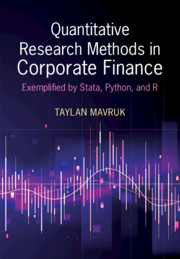Refine search
Actions for selected content:
52379 results in Statistics and Probability
Moderate deviations of many–server queues via idempotent processes – Corrigendum
-
- Journal:
- Advances in Applied Probability / Volume 57 / Issue 2 / June 2025
- Published online by Cambridge University Press:
- 24 March 2025, pp. 743-747
- Print publication:
- June 2025
-
- Article
-
- You have access
- HTML
- Export citation
Antimicrobial susceptibility of gram-negative strains isolated from bloodstream infections in China: Results from the study for monitoring antimicrobial resistance trends (SMART) 2018–2020
-
- Journal:
- Epidemiology & Infection / Volume 153 / 2025
- Published online by Cambridge University Press:
- 21 March 2025, e48
-
- Article
-
- You have access
- Open access
- HTML
- Export citation
A note on digraph splitting
- Part of
-
- Journal:
- Combinatorics, Probability and Computing / Volume 34 / Issue 4 / July 2025
- Published online by Cambridge University Press:
- 21 March 2025, pp. 559-564
-
- Article
-
- You have access
- Open access
- HTML
- Export citation
Joint mortality models based on subordinated linear hypercubes
-
- Journal:
- ASTIN Bulletin: The Journal of the IAA / Volume 55 / Issue 2 / May 2025
- Published online by Cambridge University Press:
- 21 March 2025, pp. 332-351
- Print publication:
- May 2025
-
- Article
-
- You have access
- Open access
- HTML
- Export citation
TIME-VARYING COMPLETE SUBSET AVERAGING IN A DATA-RICH ENVIRONMENT
-
- Journal:
- Econometric Theory , First View
- Published online by Cambridge University Press:
- 21 March 2025, pp. 1-56
-
- Article
- Export citation
Invasive group a streptococcal infection associated with community healthcare services delivered at home, South East England, December 2021–2023: Descriptive epidemiological study
-
- Journal:
- Epidemiology & Infection / Volume 153 / 2025
- Published online by Cambridge University Press:
- 21 March 2025, e56
-
- Article
-
- You have access
- Open access
- HTML
- Export citation

Quantitative Research Methods in Corporate Finance
- Exemplified by Stata, Python, and R
-
- Published online:
- 20 March 2025
- Print publication:
- 20 March 2025
-
- Textbook
- Export citation

Dependence Models via Hierarchical Structures
-
- Published online:
- 20 March 2025
- Print publication:
- 27 March 2025
2 - The Nature of Sampling, Non-parametric Analysis, and Hypothesis Testing
-
- Book:
- Quantitative Research Methods in Corporate Finance
- Published online:
- 20 March 2025
- Print publication:
- 20 March 2025, pp 8-20
-
- Chapter
- Export citation
7 - Time-Series Analysis
-
- Book:
- Quantitative Research Methods in Corporate Finance
- Published online:
- 20 March 2025
- Print publication:
- 20 March 2025, pp 127-163
-
- Chapter
- Export citation
10 - Selection of Models with Limited Dependent Variables
-
- Book:
- Quantitative Research Methods in Corporate Finance
- Published online:
- 20 March 2025
- Print publication:
- 20 March 2025, pp 214-249
-
- Chapter
- Export citation
Frontmatter
-
- Book:
- Quantitative Research Methods in Corporate Finance
- Published online:
- 20 March 2025
- Print publication:
- 20 March 2025, pp i-iv
-
- Chapter
- Export citation
6 - Endogeneity Bias
-
- Book:
- Quantitative Research Methods in Corporate Finance
- Published online:
- 20 March 2025
- Print publication:
- 20 March 2025, pp 90-126
-
- Chapter
- Export citation
Tables
-
- Book:
- Quantitative Research Methods in Corporate Finance
- Published online:
- 20 March 2025
- Print publication:
- 20 March 2025, pp xiv-xvi
-
- Chapter
- Export citation
3 - Basic Data Analysis in Stata
-
- Book:
- Quantitative Research Methods in Corporate Finance
- Published online:
- 20 March 2025
- Print publication:
- 20 March 2025, pp 21-39
-
- Chapter
- Export citation
Binomial distribution with delay in analysis and parametrization of Ouroboros Praos proof of stake blockchain protocol
-
- Journal:
- Probability in the Engineering and Informational Sciences / Volume 39 / Issue 4 / October 2025
- Published online by Cambridge University Press:
- 20 March 2025, pp. 520-550
-
- Article
-
- You have access
- Open access
- HTML
- Export citation
1 - Introduction
-
- Book:
- Quantitative Research Methods in Corporate Finance
- Published online:
- 20 March 2025
- Print publication:
- 20 March 2025, pp 1-7
-
- Chapter
- Export citation
Appendix for Chapter 10: Details of Models with Limited Dependent Variables
-
- Book:
- Quantitative Research Methods in Corporate Finance
- Published online:
- 20 March 2025
- Print publication:
- 20 March 2025, pp 270-280
-
- Chapter
- Export citation
11 - Writing Empirical Papers in Corporate Finance
-
- Book:
- Quantitative Research Methods in Corporate Finance
- Published online:
- 20 March 2025
- Print publication:
- 20 March 2025, pp 250-263
-
- Chapter
- Export citation
Figures
-
- Book:
- Quantitative Research Methods in Corporate Finance
- Published online:
- 20 March 2025
- Print publication:
- 20 March 2025, pp xii-xiii
-
- Chapter
- Export citation
















